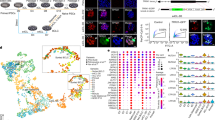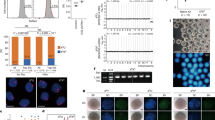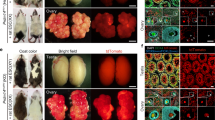Abstract
PARTHENOGENESIS occurs spontaneously in about 10% of ovulated eggs of inbred strain LT/Sv mice1,2 and is experimentally inducible in other strains by various physical and chemical agents (see ref. 3 for review). The development of most parthenotes seems normal up to the expanded blastocyst stage4. They implant in the uterus, but, for reasons unknown, are resorbed within a few days. Although they rarely survive to 8 d of gestation when they develop somites, heart muscle, amnion, and neuroepithelium, Kaufman et al.5 obtained two embryos with 25 somites by transferring parthenogenetic blastocysts to the uteri of ovariectomised females treated with exogenous hormones. Even though parthenogenetic embryos do not survive to birth, their cells contain genetic information that permits prolonged survival. If two-cell parthenotes are cultured to the blastocyst stage and then grafted to extrauterine sites such as the testis or kidney, they may survive as teratomas composed of several types of tissues and undifferentiated embryonal cells (refs 1, 6 and L.C.S. and D.S.V., unpublished). Furthermore, strain LT/Sv spontaneous ovarian teratomas contain numerous differentiated tissues composed of parthenogenetically derived cells. The questions remains—why do parthenotes not survive at the organismic level in utero? Eicher and Hoppe7 used experimental chimaeras composed of normal and abnormal embryos to transmit a recessive X-linked lethal mutation, and we considered the possibility that parthenogenetic embryonic cells might also be rescued if combined with normal embryonic cells. Here we present evidence of production of at least two viable chimaeras between normal and parthenogenetic embryos.
This is a preview of subscription content, access via your institution
Access options
Subscribe to this journal
Receive 51 print issues and online access
$199.00 per year
only $3.90 per issue
Buy this article
- Purchase on Springer Link
- Instant access to full article PDF
Prices may be subject to local taxes which are calculated during checkout
Similar content being viewed by others
References
Stevens, L. C. & Varnum, D. S. Devl Biol. 21, 364–382 (1974).
Stevens, L. C. 33rd Symp. Soc. devl Biol. (ed. Markert, C. L.) 93–106 (1975).
Tarkowski, A. K. in The Developmental Biology of Reproduction (eds Markert, C. L. & Papaconstantinou) 107–129 (Academic, New York, 1975).
Van Blerkom, J. & Runner, M. N. J. exp. Zool. 196, 113–123 (1976).
Kaufman, M. T., Barton, S. C., & Surani, M. A. Nature 265, 53–55 (1977).
Ilse, S. A., McBurney, M. W., Bramwell, S. R., Deussen, Z. A. & Graham, C. F. J. Embryol. exp. Morph. 34, 387–406 (1975).
Eicher, E. M. & Hoppe, P. C. J. exp. Zool. 183, 181–184 (1973).
Mintz, B. in Methods in Mammalian Embryology (ed. Daniel, J. C.) 186–214 (W. H. Freeman, San Francisco, 1971).
Whitten, W. K. Adv. Biosci. 6, 129–139 (1971).
Eicher, E. M. & Washburn, L. W. Proc. natn. Acad. Sci. U.S.A. (in the press).
Eppig, J. J., Kozak, L. P., Eicher, E. M. & Stevens, L. C. Nature 269, 517–518 (1977).
Author information
Authors and Affiliations
Rights and permissions
About this article
Cite this article
STEVENS, L., VARNUM, D. & EICHER, E. Viable chimaeras produced from normal and parthenogenetic mouse embryos. Nature 269, 515–517 (1977). https://doi.org/10.1038/269515a0
Received:
Accepted:
Published:
Issue Date:
DOI: https://doi.org/10.1038/269515a0
This article is cited by
-
Identification of genomic locus responsible for experimentally induced testicular teratoma 1 (ett1) on mouse Chr 18
Mammalian Genome (2014)
-
Derivation of human embryonic stem cell lines from parthenogenetic blastocysts
Cell Research (2007)
-
The use of chimeric mice in studying the effects of genomic imprinting
Russian Journal of Developmental Biology (2000)
-
In vitro development of spontaneously activated bovine oocytes
Journal of Assisted Reproduction and Genetics (1996)
-
A human parthenogenetic chimaera
Nature Genetics (1995)
Comments
By submitting a comment you agree to abide by our Terms and Community Guidelines. If you find something abusive or that does not comply with our terms or guidelines please flag it as inappropriate.



